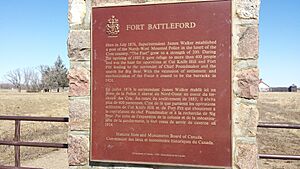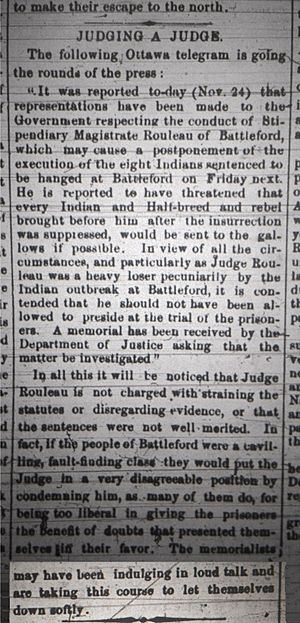Fort Battleford facts for kids
Quick facts for kids Fort Battleford |
|
|---|---|
| At the confluence of the North Saskatchewan and the Battle rivers in Battleford, Saskatchewan, Canada | |

Fort Battleford National Historic Site
|
|
| Type | Fort |
| Site information | |
| Controlled by | |
| Site history | |
| Built | 1876 |
| In use | 1876-1924 |
| Materials | Wood |
| Battles/wars | North-West Rebellion |
| Official name: Fort Battleford National Historic Site of Canada | |
| Designated: | 1923 |
| Garrison information | |
| Garrison | North-West Mounted Police |
Fort Battleford was an important early fort built by the North-West Mounted Police (NWMP) in Canada. It was the sixth fort they set up in the North-West Territories. This fort played a big part in the events of the North-West Rebellion in 1885.
At Fort Battleford, Chief Poundmaker was arrested after the conflict. Also, eight First Nations men faced justice here for their roles in serious events during the conflict. These events included the Frog Lake Massacre and the Looting of Battleford.
The fort was built where the North Saskatchewan and Battle rivers meet. This spot was great because it provided fresh water. It also offered a way to travel by river, which was an alternative to using Red River carts.
The fort was on a high plateau, making it easy to defend. From this spot, people could see far across the land. This helped them spot any possible attacks early on. During the conflict, about 500 people found safety inside the fort. They also helped to make Battleford stronger.
Contents
Why Fort Battleford Was Built
Battleford was once the capital of the North-West Territories. This was a key reason why the fort was built there. The government believed the NWMP would help guide First Nations people. They hoped it would help them change from a traveling lifestyle to a more settled one. This new way of life was similar to European societies.
Encouraging Law and Order
The government also wanted the NWMP to help new settlers. Their presence was meant to encourage everyone to respect the law. This was important for building new communities.
Learning from History
Leaders in Canada knew about the problems between Native Americans and the government in the United States. They wanted to avoid similar issues. Because many Aboriginal people lived near Battleford, a strong NWMP presence was seen as important. Both the Canadian government and First Nations hoped to find a different, more peaceful path.
Railway Changes Plans
The original plan for the Canadian Pacific Railway was to go through Battleford. However, the railway route was later changed to go further south. This change meant the capital of the North-West Territories moved from Battleford to Regina. Regina was known as Pile o' Bones back then.
Fort Battleford's Lasting Importance
Fort Battleford has a significant place in Canadian history. In 2008, a minister named Christine Tell spoke about the 125th anniversary of the 1885 Northwest Resistance. She said it was a great chance to share the stories of the Métis and First Nations peoples. Their struggles with government forces helped shape Canada into what it is today.
A Place of Refuge and Justice
Fort Otter was another name for the government house at Battleford. This site saw the largest mass execution in Canadian history. Eight First Nations men were executed here for serious crimes during the Frog Lake Massacre.
A National Historic Site
In 1923, Fort Battleford was named a national historic site of Canada. It is now known as Fort Battleford National Historic Site. This honors its role as a military base during the North-West Rebellion. It was a safe place for 500 settlers and played a part in the Siege of Battleford.



